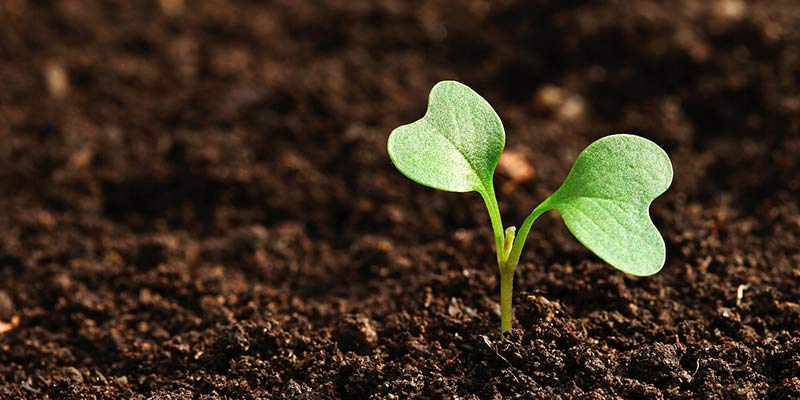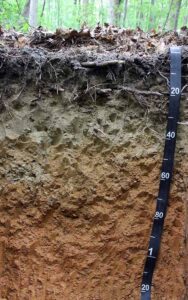Soil Scientists

Soil, created from rocks and organic matter, is home to billions of organisms that perform vital processes for life on Earth. The complexity of soil is demonstrated through its six horizons and three types of soil that can be found all over the planet.
Soil Rocks!
Soil is composed of minerals and organic matter (roots, leaves, and decaying organisms). Minerals are nonliving elements like calcium, phosphorus, iron, copper, etc. These elements combine to create rocks which in turn break down to help create soil. Rocks are broken down through a process called weathering. Some examples of weathering are plant root growth, animal scratching, freezing and thawing, and water erosion. Weathering gradually breaks the rocks into small minerals that eventually mix with organic matter to create soil filled with nutrients.
Life Underground
Soil is a living ecosystem filled with not only minerals, water, and air, but also organisms ranging from mammals to bacteria. One spoonful of soil can have up to one billion microorganisms and one million fungi parts like spores and hyphae. Worms are one of the most well-known animals living in the soil, but we also consider animals like ants, moles, voles, and slugs to be a part of the soil ecosystem. All these organisms, each with a different job, work together to create a vital part of life on Earth.
This underground ecosystem plays a necessary part in three of Earth’s most important cycles. Most organisms play a key role in nutrient cycling by assisting with the decomposition of plant debris and animal remains. They convert this waste into small compounds (nitrogen and phosphorus) that are easily absorbed by roots, fungi, and microscopic consumers. Soil also has a role in the carbon and nitrogen cycle. Bacteria in the soil fix nitrogen, meaning they convert atmospheric nitrogen to another combination, so that it can be absorbed by plants again. In the carbon cycle, soil absorbs carbon from the atmosphere and decaying matter. It is converted into organic compounds that will be stored for centuries as fossil fuels or is quickly released back to the atmosphere as carbon dioxide to help restart the cycle. It is safe to say that life above ground would not exist without life underground.
Level Up! Soil Horizon and Soil Types
Soil becomes even more complex as we explore its physical properties. Soil is divided into layers called soil horizons. There are six soil horizons (O, A, E, B, C, and R) that are distinguished by their physical and chemical properties. Scientists study these layers by taking a soil profile which is demonstrated in the image below. Think of it like a cross-section of soil. Not all areas of the ground have every soil horizon, and each layer can be different thicknesses. Research of horizons reveals important information on composition, history, drainage patterns, agricultural possibilities, and environmental impacts. After learning the horizons, use the Soil Horizon worksheet to test your knowledge.
-
-
-
-
-
- O Horizon: Also known as humus and made up of organic matter; nutrient-rich
- A Horizon: Topsoil; combination of organic matter and minerals making it darker and coarser than other horizons; fertile
- E Horizon: Named for the term eluviation also known as leaching; clay, iron and aluminum are naturally removed from this layer making it noticeably lighter
- B Horizon: Subsoil; composed of the leached materials (clay, iron, and aluminum) from the E horizon
- C Horizon: Known as parent materials which are dense, un-weathered rocks that eventually turn into soil; few living organisms
- R Horizon: Bedrock (includes rocks like limestone, sandstone, basal, granite, and quartzite)
-
-
-
-
The three main types of soil are sand, loam, and clay. Each type has its own unique properties that help us understand agricultural practices, the plants that can grow in them, and how to help those plants thrive. To understand these properties, think of the beach first. Sand is difficult to compact, and sandcastles are easily destroyed by waves. This is because sand has large grains and wide pores between them that make water and air flow quickly through the soil. Clay is the exact opposite with small particles and pores. It is easily compacted into balls or bowls because water drains slowly through this type. Lastly, loam is the middle ground and is a mixture of sand and clay. Water and air flow through its pores at an average speed, and it is usually filled with nutrients. This is the main soil found in potting soil making it great for most plants. Review the table below to learn more about the properties of sand, loam, and clay.
| Property | Sand | Loam | Clay |
| Drainage | Fast | Average to Slow | Slow |
| Aeration | Good | Medium | Poor |
| Ability to Compact | Low | Medium | High |
| Ease of Root Penetration | Very Easy | Easy | Difficult |
| Organic Matter Level | Low | Medium to High | High to Medium |
| Nutrient-Supply Capacity | Low | Medium to High | High |
Activity: Soil Type Sorter
Materials: clear jar, trowel, soil, water
- Fill half of your container with soil. Make sure to remove mulch or other materials on top of the soil before you dig into the soil.
- Pour water into your jar until 2/3 of the container is filled
- Put on the lid and find a safe space for your container. Wait 24 hours for the particles to settle. You are welcome to check its progress but make sure you do not move the container.
- Observe the distinct layers of soil particles and guess which layer is sand, loam, and clay.
- Try the experiment again to see if a different area will create different or wider layers.
Why and how did the soil create these layers? The soil will separate into different layers depending on the size, weight, and ability to hold water. Clay particles will settle at the top, then loam, and sand will be at the bottom. You may even see small organic matter floating at the top of the water.
Nature Exploration
Explore your soil with a soil survey. Mark a square of 1ft by 1ft. Dig up the soil to discover what organisms you may find. Use a hand lens to look at the soil closely to find roots, fungal hyphae, seeds, rocks, and small bugs. You can also use a sieve to sift the soil out and reveal other small organisms and materials living in your soil. The more life you find, the healthier the soil!
Observe the weathering process near you. It can take several years or millions of years for weathering to take place. It depends on the type of rock, climate, vegetation, and moisture of its environment. Search for rock as you hike a mountain, adventure along a riverbed, or walk down the sidewalk. Observe cracks, crevices, rounded and smooth edges, rust, etc. And think about what may have caused these. Guess how long it would take the rocks to fully break down.
If you are feeling creative, create a mud painting. Add water to a bowl of dirt and use brushes or your fingers to draw. Use different types or horizons of soil to create different paint colors. Soil with more organic matter will be darker than leached or sandy soil. You can paint on paper, rocks, fences, or sidewalks.
Books & Resources
Under Your Feet: Soil, Sand, and Everything Underground by Royal Horticulture Society
Up in the Garden and Down in the Dirt by Kate Messner
Soil Horizons Worksheet
Minerals & Rock Handout

